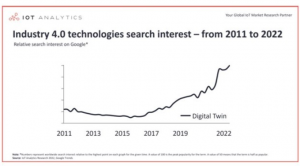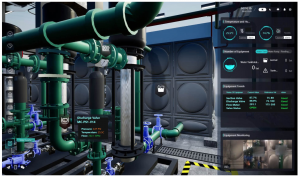
06 Dec Digital Twins are Skyrocketing – What You Need to Know
IoT Analytics published a report on how the phrase “Digital Twin” skyrocketed in the last 5 years. One big reason? COVID-19 forced all non-essential employees to work from home.

How “Digital Twin” skyrocketed in 5 years.
What’s a Digital Twin?
According to IBM:
“A digital twin is a virtual model designed to accurately reflect a physical object. The object being studied — for example, a wind turbine — is outfitted with various sensors related to vital areas of functionality. These sensors produce data about different aspects of the physical object’s performance, such as energy output, temperature, weather conditions and more. This data is then relayed to a processing system and applied to the digital copy.
Once informed with such data, the virtual model can be used to run simulations, study performance issues and generate possible improvements, all with the goal of generating valuable insights — which can then be applied back to the original physical object.”
Real World Application of Digital Twin Technology in OT
Your operator typically sits in a control room watching a set of large monitors for anomalies or changes in real-time data such as pressure, temperature, flow rates, pump speed, etc. The operator might have cameras that s/he could refer to that show various locations across the plant.
When an error abruptly appears on the monitors, your operator’s typical response would be to call out to the field crew making rounds throughout the facility. The field crew would then inspect the area for any visible issues and proceed to troubleshoot along with the control room operator. Unfortunately, the field crew does not have access to the maintenance data (who performed the maintenance, when, which parts were used). Now, they must inquire of the operator to determine if the issue was maintenance-related or something else.
So, What’s the Danger of NOT having a Digital Twin?
All the while, the field crew is literally standing in the line of fire. 500+ PSI of compressed natural gas flows through the pipe directly next to them.
This is a huge safety concern not only for the company, but also for the personnel doing the troubleshooting. A death could halt operations until a team of investigators performs a root cause investigation. This would cause a loss of productivity amounting to $100,000+.
Leadership should arm field crews with all pertinent information for troubleshooting to limit their time in the Red Zone. Field crews must get in and out quickly and efficiently.
Here’s what Your Digital Twin would look like…
Imagine a 3D virtual world (Digital Twin) of your entire plant or pipeline network where every pipe, sensor, valve, or flow meter are shown in real-time. Your operators and field crews can visualize their entire process without having to step foot into the Red Zone and put themselves needlessly in danger.
You could “walk” through your plant as if you were there in person. When you walk up to a valve, documentation appears outlining when the last PM or replacement was performed, and by whom, all in this Digital Twin. Walk further and you watch your flow, temperature, and pressure in real-time.

Your 3D virtual world (Digital Twin) of your entire plant or pipeline network.
Now imagine that you’re a control room operator. One of your screens flashes a warning about your system. The traditional response would be to call out to the field crew to take a look at the problem, potentially putting them in danger.
Instead, you have the remarkable Digital Twin to save everyone’s day and life. Before calling your field crew, you can quickly go to the warning area via your trusty Digital Twin.
This virtual world shows you that your automated main valve is throwing an error code for “Closing Time Exceeded.” Based on this initial error code, you determine that something is preventing that valve from opening and closing at the desired speed. You suspect that the valve actuator has lost pressure and is lacking performance.
… And How the Digital Twin Literally Saves the Day
After clicking on the valve, you find all maintenance records for that valve, all within the Digital Twin. Turns out the valve is out of spec for lubrication and the ambient temperature is 28 degrees. You realize that your initial suspicion of a failing valve actuator is likely not true. Instead, the lubricant in the valve is old and in need of replacement.
Armed with this information, you tell your field crew that the valve needs to be lubricated and function tested. The result is that you’ve mitigated their risk and saved them time from going out and doing the initial troubleshooting in the Red Zone.
The beauty of this particular example is that the Digital Twin has:
- Saved you money in opportunity cost of the operator and field crew
- Fixed the root cause of the problem
Don’t have a centralized control room that can control hundreds of facilities remotely?
Fast-growing companies have not had time to implement a centralized control room for their operations. Acquisitions of operating land and facilities bring complications when it comes time to integrate controls under one roof.
With fast growth, in-house engineers can’t be bothered to adapt each part of the field into one SCADA system. As a result, companies instead run their operations using piecemeal SCADA components.
Having piecemeal SCADA systems creates confusion between interfaces, devices, and networks, and makes it difficult to implement region-wide (or company-wide) automation. This is a huge problem for leak detection, load balancing and other global automation systems.
Companies with non-uniform SCADA systems have to hire extra field personnel to monitor and turn valves when needed. This creates more overhead and increases risk for injury.
A purpose-built SCADA system that is scalable allows companies to implement a centralized control room. Now, operators can control and monitor entire fields, without having to hire extra persons to be on standby.
UTSI has 40 years of experience designing and implementing SCADA and control rooms for large and small companies across the globe.
Don’t have automated instrumentation that mitigates risk, optimizes efficiency, & protects your revenue?
A field operator can cost a company anywhere from $20 to $40/hour in base pay – not including the cost of insurance, fuel, truck maintenance, and training. Companies that lack automated instrumentation such as valves and pumps must have field operators to turn valves, adjust pumps, and check flowmeters and sensors. This option is a risky one – field operators can and do get hurt!
Instead, companies should automate valves, pumps, and other instruments to allow control room operators the ability to control and monitor data points and instruments remotely.
UTSI successfully picks the right instrumentation for your needs, reduces risk for field personnel, and optimizes response time to changing conditions. The result is an automated system that depends on fewer people to run the process. This means less overhead, reduced safety risk, and more efficient operations = higher profit margins!
Don’t have automated alarms for your facility that warn your operators of process issues & failures miles away?
Properly set alarms can be useful in pin-pointing looming issues within your plant or process. Along with automated instruments, SCADA systems are optimized to show operators when a valve is failing to close properly, when a flow meter is showing null values, or when a pump is beginning to show signs of wear. Alarms give operators the ability to catch the beginning of an impending issue, or a problem with a particular device.
UTSI’s software engineers build software that alerts operators about issues and implements a clear display, so that your operators don’t miss a thing. A new operator could miss an alarm if the display is not set up clearly and definitively. An alarm that goes unnoticed could spiral into a system-wide shut down, or worse, an explosion or high-pressure liquids and gases potentially causing $ Millions of damages, lost productivity, and lives. With 39 years of experience in control rooms, UTSI’s customized display software design considers every aspect of the industrial process and leaves no stone unturned for the best alarm system in the industry.
Critical Infrastructure in the US is in Trouble
The reality of Operational Technology within Critical Infrastructure is alarming. The average age of critical infrastructure is more than 50 years old. The average age of critical infrastructure STEM roles rose from 55 (in 2006) to 65 (in 2022).
The workforce is aging out and the experts remaining will be gone within the decade. For every Five critical infrastructure experts leaving the industry, only One is replacing them. Companies are struggling to find Critical Infrastructure experts to run their Operational Technologies, and this trend is not going anywhere.
Our world is interdependent. The same water systems that provide our neighborhoods with water also deliver it to cool generators, turbines, refineries, nuclear facilities, and other critical aspects of industries that power our economy. Each of these critical infrastructure industries rely on secure and effective Operational Technology and they all rely on each other to keep America the great superpower that it is.
Ready to Assess Your Company’s Critical Infrastructure for Vulnerabilities from Threat Actors and Inefficiencies?
Give us a call or email to schedule an initial consultation. It’s time to take control of your Operational Technology and Critical Infrastructure. Our Solutions Engineers are looking forward to your no-obligation consultation.


